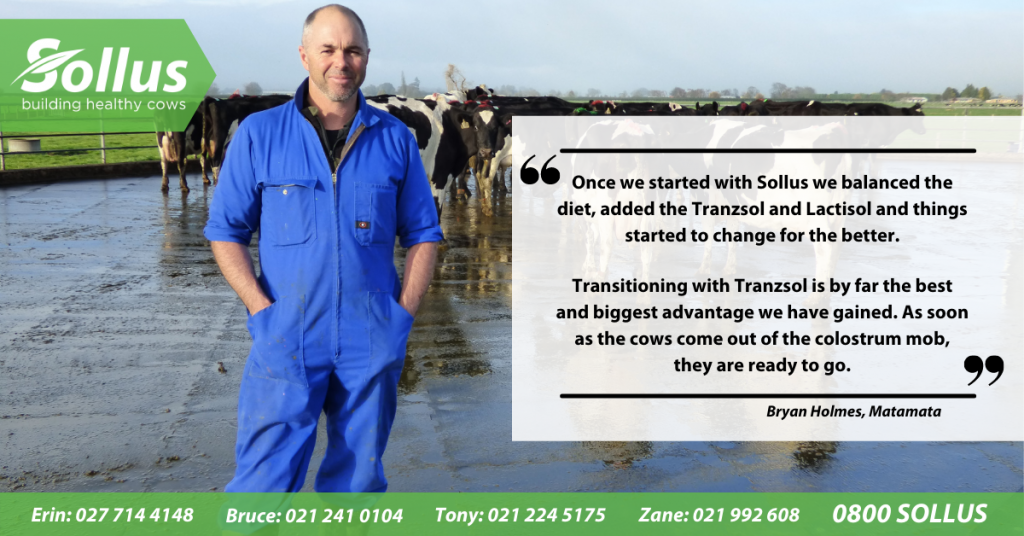Testimonial – Bryan Holmes, Matamata

Making his farm system more “cow-centric” and basing his feeding system to his herd’s needs has started to pay dividends for Matamata farmer Bryan Holmes.
Bryan’s 720 head herd is split 50:50 between spring and autumn calving but one problem has underscored the past years’ calving is having to grapple with milk fever at levels that were becoming unmanageable.
“The level of milk fever we were having right through calving, it just left me thinking there must be something we can do to improve things,” he says.
He had tried adjusting the herd’s nutritional mineral input before, but it wasn’t until he opted for Sollus that he found a workable solution.
“It was only after a conversation with a neighbour who encouraged me to try Sollus. He had enjoyed some really good success with his milk fever problems and told me it was a no brainer.”
With a couple of seasons of Sollus behind him and a significant re-working of the herd’s dietary inputs, accompanied by Tranzsol for transitioning and Lactisol for the milking season, he believes he is now well on the right track.
“This autumn calving, I was half-way through before we even had our first case of milk fever, that’s a big change from what we were used to getting.”
Getting Sollus on board meant Bryan had to tip some of the usual beliefs about grass based feeding out, and adjust to feeding supplements even when there was plenty of grass on hand over spring-time.
“We had always thought we were feeding the cow a lot of supplement, but it had not been balanced in a way to get the most out of them. We had to look far more closely at their diet, and make changes to have a diet that delivered them the best combination of feed, all year.”
In the past it had been more a case of the cows fitting into the grass growth curve, opening up the grass input when grass took off in spring, and winding supplement back.
The diet of grass, silage, maize silage and in-shed DDG meant the cows were still performing well at about 500kgMS a year but that was eclipsed by the milk-fever, reproduction and lameness issues accompanying that.
“It was a bit of a leap of faith to go with Sollus’s recommendations, loading up with supplement feed costs early in the season, and continuing to feed those supplements even as the grass leapt out of the ground.”
The regime included tapioca for carbohydrates combined with canola for additional protein supplement.
Bryan utilises Tranzsol for transitioning 14 days prior to calving, providing adequate calcium and mineral levels to support the switch to lactation.
“Transitioning with Tranzsol is by far the best and biggest advantage we have gained out of the whole change in the system. As soon as the cows come out of the colostrum mob, they are ready to go, she is getting all her energy out of the diet we feed her, not out of her body.”
The shift to Lactisol through lactation keeps calcium and mineral levels well maintained, limiting the draw on the cow’s body reserves.
“Combined with Lactisol, we worked out what diet would give them the most energy to cycle and maintain pregnancy and to lift milksolids.”
The results have been reassuring, with per cow daily milk production up by 2-3 litres per cow through the entire lactation, with the herd on target to average 570kgMS a cow a year, close to Bryan’s goal of achieving 100% bodyweight in production.
Bryan and his staff also appreciate the lower stress levels over calving with less milk fever issues.
“This has been the best calving we have had in the whole time I have been here. And I do believe we are on track to address our in-calf and lameness problems by dealing with that first.”
He acknowledges re-tuning the diet does involve more work, and it can be daunting to commit to significant supplementary feed costs early in the season.
“But once we started with Sollus we balanced their diet, added the Tranzsol and Lactisol and things started to change for the better – now we are really just fine-tuning around the edges.”